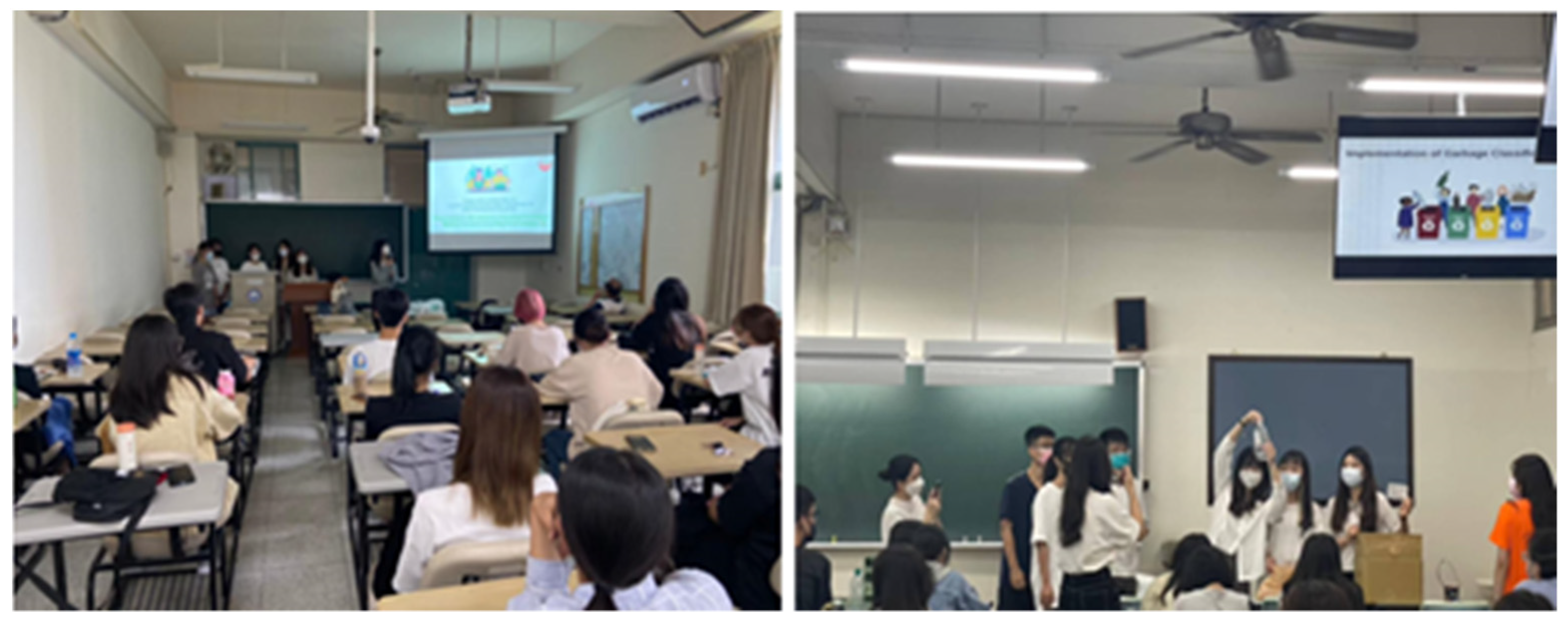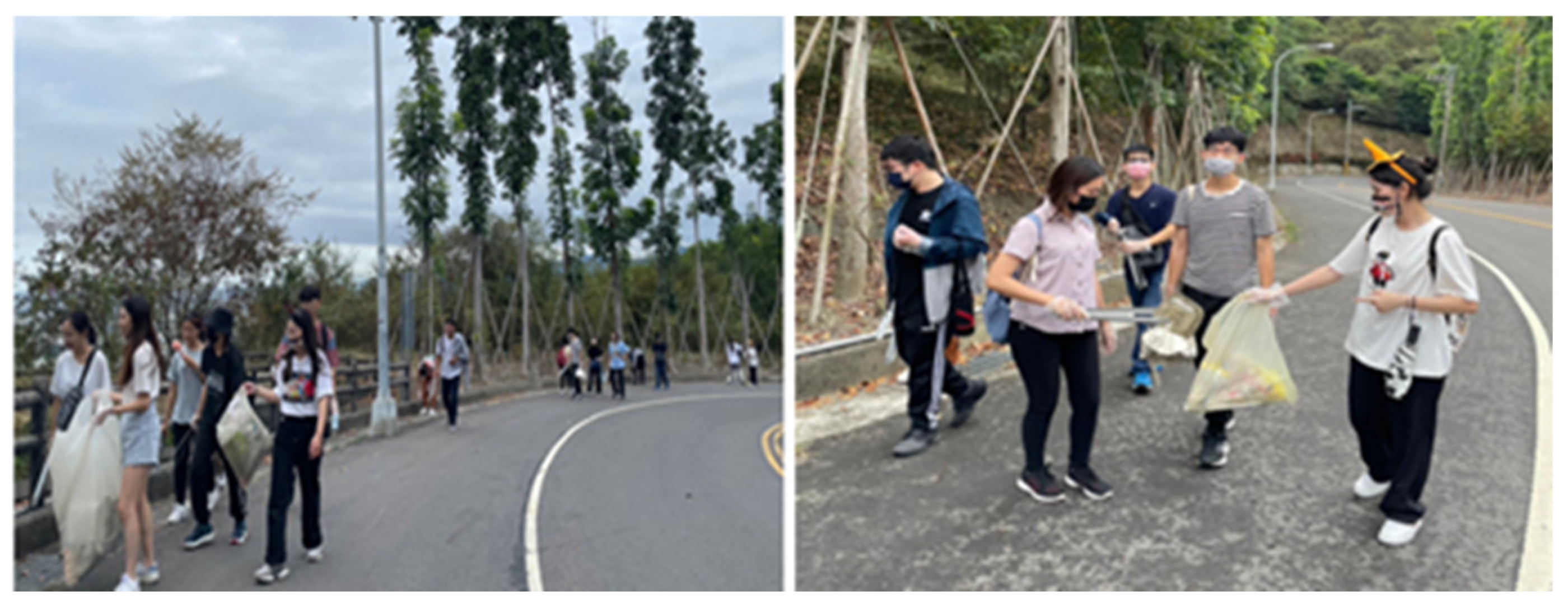Environmental Movement Regardless of Nationality: International Students’ Attitude toward Environmental Protection and Environmental Awareness in Taiwan †
Abstract
:1. Introduction
2. Literature Review
2.1. Environmental Protection
2.2. Environmental Education
2.3. Environmental Awareness
2.4. Green Behavior
3. Methodology
4. Movements for Environmental Protection
4.1. Class Dissemination
4.2. Mountain Cleaning
5. Conclusions and Recommendations
Author Contributions
Funding
Institutional Review Board Statement
Informed Consent Statement
Data Availability Statement
Conflicts of Interest
References
- Science Park. The Different Kinds of Waste Produced by Manufacturing Industries. 2019. Available online: https://sciencepark.com.ph/blog/waste-management/ (accessed on 7 January 2020).
- Olivier, J. For Many Taiwanese, “Buying Green” Has Long Been a Priority. AmCham Taiwan. 19 August 2021. Available online: https://topics.amcham.com.tw/2021/08/taiwanese-buying-green-priority/?fbclid=IwAR25PepbLXUFmdcTr20-CeBx-STfN2FyKaY0_0Uu1AyG0iuXeiy21lSOoV8 (accessed on 19 August 2021).
- Green Peace. Greenpeace Global Review 2019: The Climate Battle Will Never Give In. 2019. Available online: https://www.greenpeace.org/taiwan/update/12548/%E7%B6%A0%E8%89%B2%E5%92%8C%E5%B9%B32019%E5%85%A8%E7%90%83%E5%9B%9E%E9%A1%A7%EF%BC%9A%E6%B0%A3%E5%80%99%E6%88%B0%E5%BD%B9%E7%B5%95%E4%B8%8D%E8%AE%93%E6%AD%A5/ (accessed on 15 January 2020).
- Atmaja RT, P.; Sulastri, S.; Nazli, N. Development of students learning module for disaster and environmental knowledge subject for undergraduate students of Universitas Syiah Kuala. JIPI (Jurnal IPA Pembelajaran IPA) 2021, 5, 48–56. [Google Scholar] [CrossRef]
- Syiah Kuala University. USK Waste Management Becomes a Central Reference. Syiah Kuala University. 22 July 2022. Available online: https://usk.ac.id/tata-kelola-sampah-usk-jadi-rujukan-pusat/ (accessed on 22 July 2022).
- EPA. What Is Environmental Education? U.S. Environmental Protection Agency: Washington, DC, USA, 2023. Available online: https://www.epa.gov/education/what-environmental-education (accessed on 2 July 2024).
- Sharma, N.; Paço, A.; Upadhyay, D. Option or necessity: Role of environmental education as transformative change agent. Eval. Program Plan. 2023, 97, 102244. [Google Scholar] [CrossRef] [PubMed]
- Calculli, C.; D’Uggento, A.M.; Labarile, A.; Ribecco, N. Evaluating people’s awareness about climate changes and environmental issues: A case study. J. Clean. Prod. 2021, 324, 129244. [Google Scholar] [CrossRef]
- Mountain Riders. Ensemble Pour Nos Montagnes. 2020. Available online: https://www.mountain-riders.org/ (accessed on 8 April 2020).
- Geneva Environment Network. Plastic Waste in Mountains|Geneva Beat Plastic Pollution Dialogues & International Mountain Day 2021 Plastic Waste in Mountains. 2021. Available online: https://www.genevaenvironmentnetwork.org/events/plastic-waste-in-mountains-geneva-beat-plastic-pollution-dialogues-international-mountain-day-2021/ (accessed on 10 December 2021).
- Tsai, P. The Innovation Strategies of Environmental Education and Consciousness of Ecological Protection: A Case Study of the Clean Mountain. Unpublished Master’s Thesis, University of Minghsin, Hsinchu, Taiwan, 2020. [Google Scholar]
- UIAA. Mountain Days Campaign for Waste Collection and Sustainable Practices in Europe; UIAA: Bern, Switzerland, 2021; Available online: https://theuiaa.org/uiaa/mountain-days-campaign-for-waste-collection-and-sustainable-practices-in-europe/ (accessed on 1 August 2016).
- Shiu, W. A Study of Green Human Resource Management, Green Organizational Climate, and Employees’ Green Behavior. Unpublished Master’s Thesis, University of Ling Tung, Airiti Library, Taichung, Taiwan, 2022. [Google Scholar]
- Ecobin. What Are Green Behaviour? 7 October 2019. Available online: https://www.ecobin.com.au/blogs/blog/what-is-green-behaviour/ (accessed on 7 October 2019).
- George Washington University. Trash, Recycling, and Compost at GW; George Washington University: Washington, DC, USA, 2021; Available online: https://sustainability.gwu.edu/waste (accessed on 1 July 2021).
- Sumner Byrne. Chou Hall: Achieving Zero Waste on the UC Berkeley Campus; U.S. Green Building Council, Inc.: Atlanta, GA, USA, 2022; Available online: https://www.usgbc.org/articles/chou-hall-achieving-zero-waste-uc-berkeley-campus (accessed on 16 June 2022).
- University of Waterloo. Zero Waste Week 2019; University of Waterloo: Waterloo, ON, Canada, 2019; Available online: https://uwaterloo.ca/sustainability/events/zero-waste-week-2019 (accessed on 21 October 2019).




| 5 Tips for University Course Material | |
|---|---|
| Plant trees or flowers | Establish a Garbage Bank to concern for the surrounding environment |
| Form a group to perform some environmental movements | Open lectures with an environment curriculum; class dissemination |
| Visit natural environments or use places such as school settings | |
| Green Behavior | |
|---|---|
| The University of George Washington [15] |
|
| The University of California Berkeley [16] | Replace the plastic bottles in vending machines with cans and glasses |
| The University of Waterloo [17] | Hold a garbage marathon for a zero-waste challenge |
| Recycling at CYUT | |
|---|---|
| Blue | Paper: books, cartons, coated paper, newspapers, photocopying paper, promotional paper, posters, leaflets, etc. |
| Brown | Aluminum cans: iron cans, bottles and cans of beverages, drinks, cola, cans, beer, etc. |
| Green | Aluminum foil pack (carton pack with a layer of transparent film): green tea, black tea, milk tea, juice, etc. |
| Yellow | Plastic bottles and cans that have recycling signs: bottled water, PET bottles, bubble tea, shower, cleaning supplies, straws, etc. |
| Black | General garbage: toilet paper, garbage bags, plastic bags, leaves, bamboo chopsticks, etc. |
| White | Glass bottles and cans for beverages: soy sauce, wine bottles, etc. |
| Number of Departments | Number of Students | |
|---|---|---|
| KPI | 2 | 60 |
| Actual Quantity | 4 | 112 |
| Department | Grade | Numbers |
|---|---|---|
| Department of Marketing and Logistics Management | Freshman | 14 |
| Department of Information Management | Freshman Sophomore Junior | 10 |
| Number of Attendances | Amounts of Garbage | |
|---|---|---|
| KPI | 24 | 5 kg |
| Actual Quantity | 30 | 6 kg |
| Number of Classrooms | Number of Views | |
|---|---|---|
| KPI | 10 | 500 |
| Actual Quantity | 15 | 800 |
Disclaimer/Publisher’s Note: The statements, opinions and data contained in all publications are solely those of the individual author(s) and contributor(s) and not of MDPI and/or the editor(s). MDPI and/or the editor(s) disclaim responsibility for any injury to people or property resulting from any ideas, methods, instructions or products referred to in the content. |
© 2024 by the authors. Licensee MDPI, Basel, Switzerland. This article is an open access article distributed under the terms and conditions of the Creative Commons Attribution (CC BY) license (https://creativecommons.org/licenses/by/4.0/).
Share and Cite
Yang, K.-F.; Liu, P.-R.; Zheng, Y.-H.; Peng, Y.-J.; Wang, H.-Y.; Huang, Y.-F. Environmental Movement Regardless of Nationality: International Students’ Attitude toward Environmental Protection and Environmental Awareness in Taiwan. Eng. Proc. 2024, 74, 26. https://doi.org/10.3390/engproc2024074026
Yang K-F, Liu P-R, Zheng Y-H, Peng Y-J, Wang H-Y, Huang Y-F. Environmental Movement Regardless of Nationality: International Students’ Attitude toward Environmental Protection and Environmental Awareness in Taiwan. Engineering Proceedings. 2024; 74(1):26. https://doi.org/10.3390/engproc2024074026
Chicago/Turabian StyleYang, Kai-Fu, Pei-Rong Liu, Yu-Han Zheng, Yu-Jie Peng, Hai-Yan Wang, and Yi-Fang Huang. 2024. "Environmental Movement Regardless of Nationality: International Students’ Attitude toward Environmental Protection and Environmental Awareness in Taiwan" Engineering Proceedings 74, no. 1: 26. https://doi.org/10.3390/engproc2024074026





